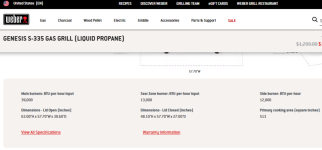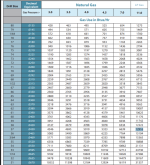You are using an out of date browser. It may not display this or other websites correctly.
You should upgrade or use an alternative browser.
You should upgrade or use an alternative browser.
Natural gas grill question
- Thread starter JimV
- Start date
Ok all I came back with a non scientific update. I rarely convert any of my grills. But there have been too many great deals on NG's so I grabbed this Gen II 310 NG for $100 and converted it with the cones and orifices from a Genesis 300 series front control. I did not use fancy equipment or anything other than my eyeballs. Well I did use a magnifying glass and some cheater glasses. Anyway I could easily see the differences in the orifice sizes and the cones looked identical in size under magnification so I gave it a try. They installed easily and worked perfectly. I adjusted the air shutters on the burners from their NG positions to a better propane tune. Its burning correctly and no leaks. This information is for entertainment purposes only  try at your own risk.
try at your own risk. 
Josh Dekubber
TVWBB Hall of Fame
I've converted a few different Weber models with each one being a different situation/procedure. It's always nice to get experience in different areas.Ok all I came back with a non scientific update. I rarely convert any of my grills. But there have been too many great deals on NG's so I grabbed this Gen II 310 NG for $100 and converted it with the cones and orifices from a Genesis 300 series front control. I did not use fancy equipment or anything other than my eyeballs. Well I did use a magnifying glass and some cheater glasses. Anyway I could easily see the differences in the orifice sizes and the cones looked identical in size under magnification so I gave it a try. They installed easily and worked perfectly. I adjusted the air shutters on the burners from their NG positions to a better propane tune. Its burning correctly and no leaks. This information is for entertainment purposes onlytry at your own risk.

Hey Josh and Larry.... Interesting enough I had a bunch of cones and orifices in bags that I had saved and the one thing that through me for a loop was that of the NG orifices some were larger than others. I assume that Weber tunes the BTU's via the jet so maybe the slight difference in jet size or orifice size is due to that particular grills set up for BTU output.....a good example might be the mighty LX grills that you guys love so much that are designed for every burner to have a sear function.....I would think that would be jetted differently for that feature. So my goal when converting a grill would be for it to burn clean like it was intended but my end thought is that I may have got it close to correct but they could still be running a little rich or lean. I was tuning the shutters because the burners were making that wind noise that I have noticed with several of the more modern Gen II's including my personal grill. I didnt move the shutter much ....just a little bit more closed as it was in the almost all the way open position ...previous owner may have been playing with them as well. The grill flames are very very good....and it cruised right up to 500 with no problem so I am very satisfied.
DanHoo
TVWBB 1-Star Olympian
@JimV , you may already know this, but the front control 300 have two burner sizes. The main burners are 12.6K BTU and the sear is 10K BTU.
I seem to recall the Genesis II went to 13K main burner and 9K sear.
I was under the impression the orifice was the final limit for output and the passages and channels of the valve controlled less than full throttle.
I seem to recall the Genesis II went to 13K main burner and 9K sear.
I was under the impression the orifice was the final limit for output and the passages and channels of the valve controlled less than full throttle.
LMichaels
TVWBB 2-Star Olympian
I don't think that would be the case. Through the years though if you look at old Weber Specs some years/models they are 10k burners, some are 12k, some are 11k, some models spec a regulator and some don't. That will account for them using basically same burners, and valves and simply altering orifices to accommodate that
DanHoo
TVWBB 1-Star Olympian
I don't think that would be the case. Through the years though if you look at old Weber Specs some years/models they are 10k burners, some are 12k, some are 11k, some models spec a regulator and some don't. That will account for them using basically same burners, and valves and simply altering orifices to accommodate that
For the front control Genesis, the BTU Specs changed through the generations.
2011-16 the total BTU for main burners is38K with a 10K sear.
Genesis II total BTU for main burners is 39K with a 9K sear
Current model E330: main burners are 39K with a 13K sear
And actually it's not the "burners" that are different BTU as the burner does not "negotiate" BTU. It's basically how much gas and pressure behind that gas there is. Burner is a burner
Depends on what you call a "burner" is it just the tube or the complete set of pieces. When I wrote "burner" I'm referring to the complete set that the Valve + Orifice + Tube, and I agree BTU is driven by how much fuel is delivered into the tube. Weber Spec's refer to this as burner output.
Very interesting.......Dan I did not know that. I have however noticed when disassembling Gen II's that the air shutter for the sear burner is set to a different more closed position. Now that you have educated me I really want to check to see if the orifice and cone have different size holes then the main burners do.......I would imagine that they do but it is so slight that I wont be able to see with a naked eye. That said as I mentioned in my previous posts......when I was fumbling through my bag of cones and orifices I learned that not all NG jet sizes or orifice sizes were the same.....yes it was a larger hole than the propane but they were different from grill to grill. I love learning this stuff. Just as much as I hate to hear all of the internet keyboard guys telling everyone to just easily convert your ng to propane with this random set of orifices from Amazon. Sure it lights up and creates fire.......but that aint a well tuned fire. 
DanHoo
TVWBB 1-Star Olympian



